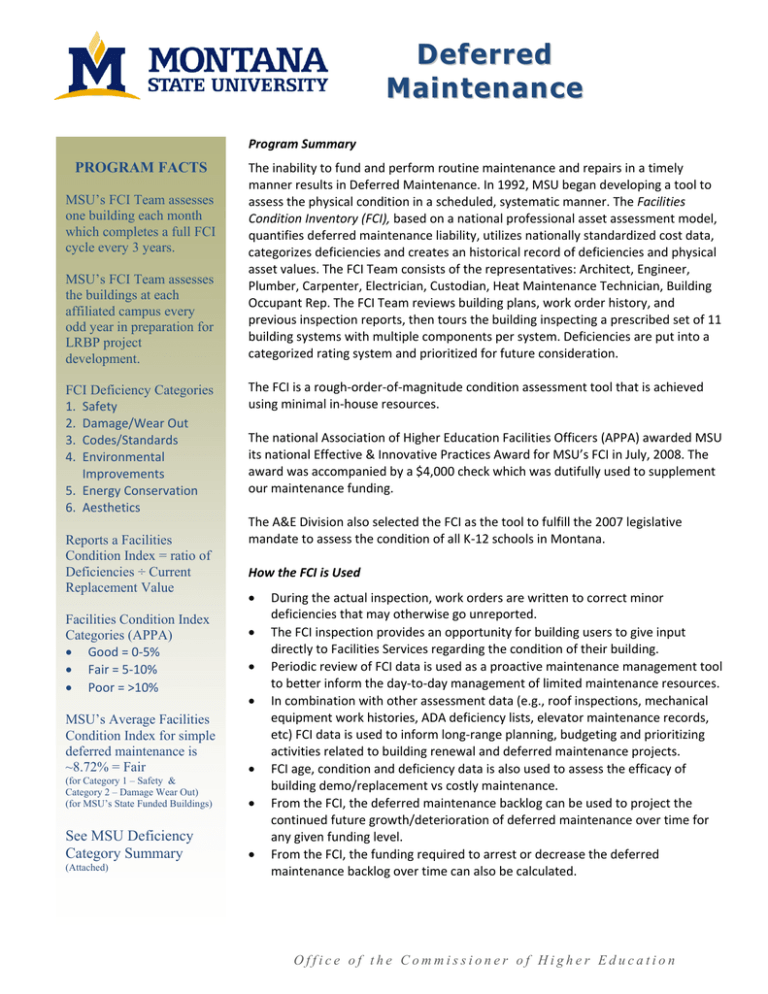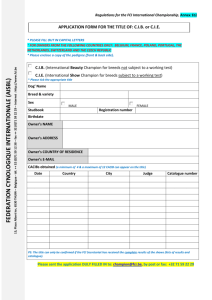Deferred Maintenance - Montana University System
advertisement

Deferred Maintenance Program Summary PROGRAM FACTS MSU’s FCI Team assesses one building each month which completes a full FCI cycle every 3 years. MSU’s FCI Team assesses the buildings at each affiliated campus every odd year in preparation for LRBP project development. FCI Deficiency Categories 1. Safety 2. Damage/Wear Out 3. Codes/Standards 4. Environmental Improvements 5. Energy Conservation 6. Aesthetics Reports a Facilities Condition Index = ratio of Deficiencies ÷ Current Replacement Value Facilities Condition Index Categories (APPA) • Good = 0-5% • Fair = 5-10% • Poor = >10% The inability to fund and perform routine maintenance and repairs in a timely manner results in Deferred Maintenance. In 1992, MSU began developing a tool to assess the physical condition in a scheduled, systematic manner. The Facilities Condition Inventory (FCI), based on a national professional asset assessment model, quantifies deferred maintenance liability, utilizes nationally standardized cost data, categorizes deficiencies and creates an historical record of deficiencies and physical asset values. The FCI Team consists of the representatives: Architect, Engineer, Plumber, Carpenter, Electrician, Custodian, Heat Maintenance Technician, Building Occupant Rep. The FCI Team reviews building plans, work order history, and previous inspection reports, then tours the building inspecting a prescribed set of 11 building systems with multiple components per system. Deficiencies are put into a categorized rating system and prioritized for future consideration. The FCI is a rough-order-of-magnitude condition assessment tool that is achieved using minimal in-house resources. The national Association of Higher Education Facilities Officers (APPA) awarded MSU its national Effective & Innovative Practices Award for MSU’s FCI in July, 2008. The award was accompanied by a $4,000 check which was dutifully used to supplement our maintenance funding. The A&E Division also selected the FCI as the tool to fulfill the 2007 legislative mandate to assess the condition of all K-12 schools in Montana. How the FCI is Used • • • • MSU’s Average Facilities Condition Index for simple deferred maintenance is ~8.72% = Fair • (for Category 1 – Safety & Category 2 – Damage Wear Out) (for MSU’s State Funded Buildings) • See MSU Deficiency Category Summary • (Attached) During the actual inspection, work orders are written to correct minor deficiencies that may otherwise go unreported. The FCI inspection provides an opportunity for building users to give input directly to Facilities Services regarding the condition of their building. Periodic review of FCI data is used as a proactive maintenance management tool to better inform the day-to-day management of limited maintenance resources. In combination with other assessment data (e.g., roof inspections, mechanical equipment work histories, ADA deficiency lists, elevator maintenance records, etc) FCI data is used to inform long-range planning, budgeting and prioritizing activities related to building renewal and deferred maintenance projects. FCI age, condition and deficiency data is also used to assess the efficacy of building demo/replacement vs costly maintenance. From the FCI, the deferred maintenance backlog can be used to project the continued future growth/deterioration of deferred maintenance over time for any given funding level. From the FCI, the funding required to arrest or decrease the deferred maintenance backlog over time can also be calculated. Office of the Commissioner of Higher Education




